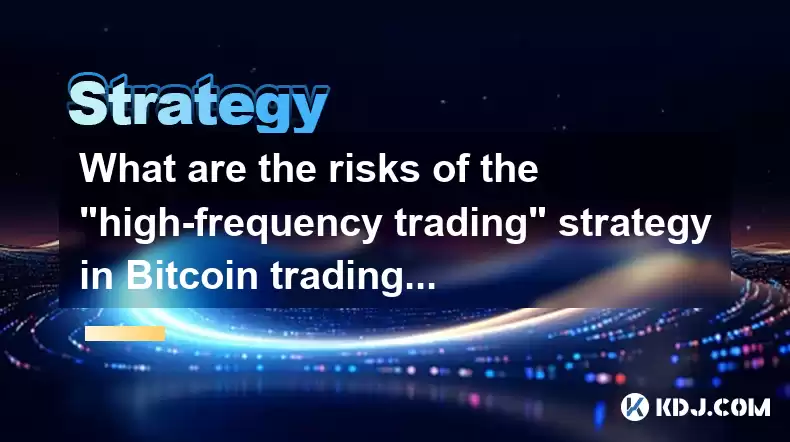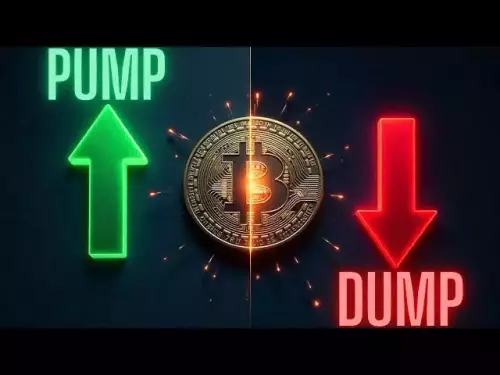-
 bitcoin
bitcoin $112139.774561 USD
-1.82% -
 ethereum
ethereum $3970.329568 USD
-3.85% -
 tether
tether $1.000078 USD
0.01% -
 xrp
xrp $2.611653 USD
-1.08% -
 bnb
bnb $1099.982737 USD
-3.67% -
 solana
solana $193.702075 USD
-3.33% -
 usd-coin
usd-coin $0.999832 USD
0.00% -
 dogecoin
dogecoin $0.193302 USD
-3.68% -
 tron
tron $0.294800 USD
-1.45% -
 cardano
cardano $0.642524 USD
-3.89% -
 hyperliquid
hyperliquid $47.524848 USD
1.27% -
 chainlink
chainlink $17.842256 USD
-2.41% -
 bitcoin-cash
bitcoin-cash $561.265025 USD
1.01% -
 stellar
stellar $0.317292 USD
-2.07% -
 ethena-usde
ethena-usde $0.999303 USD
0.01%
What are the risks of the "high-frequency trading" strategy in Bitcoin trading?
High-frequency trading in Bitcoin carries specific risks such as market manipulation, systemic risk, execution risk, volatility, and regulatory concerns, necessitating robust risk management strategies.
Feb 25, 2025 at 05:42 am

- Understanding High-Frequency Trading (HFT)
- Specific Risks Associated with HFT in Bitcoin Trading
- Effective Risk Management Strategies
HFT refers to a trading strategy that involves executing a large number of orders rapidly. It leverages computer algorithms to analyze market data and identify potential trading opportunities. In the context of Bitcoin trading, HFT strategies may involve:
- Arbitraging price discrepancies across exchanges
- Capitalizing on order imbalances
- Targeting market inefficiencies
- Market Manipulation: HFT algorithms can exploit market inefficiencies and artificially create price movements, potentially leading to false signals and market distortions.
- Systemic Risk: HFT relies on sophisticated algorithms and technology, which increases the risk of system failures or technological disruptions.
- Execution Risk: The high volume and speed of HFT orders can lead to order delays, fills at unfavorable prices, or partial fills, resulting in trading losses.
- Volatility: Bitcoin's high price volatility can make it challenging for HFT algorithms to accurately gauge market movements and execute trades effectively.
- Regulatory Concerns: HFT practices may fall under regulatory scrutiny, as they raise concerns about fair market competition and potential market abuses.
- Controlled Execution: HFT algorithms should be configured to execute orders gradually over time, reducing market impact and mitigating the risk of order imbalances.
- Backtesting and Monitoring: Regularly test and monitor HFT algorithms to ensure their performance meets expectations and adapt to changing market conditions.
- Diversification: Distribute trading across multiple cryptocurrency exchanges and trading pairs to reduce single-source risks.
- Quantify and Manage Latency: Measure and minimize latency across the entire trading process, from market data acquisition to order execution.
- Contingency Planning: Establish emergency protocols and backups in case of system failures or technological disruptions that could impact HFT trading.
- Is HFT a viable strategy for retail Bitcoin traders?
- Generally, HFT is more suitable for experienced traders with specialized knowledge and access to robust infrastructure. Retail traders may consider less sophisticated trading strategies.
- How can I protect myself from HFT market manipulation?
- Understand market dynamics, be wary of sudden or extreme price movements, and diversify your trading portfolio across different assets.
- What are the future prospects of HFT in Bitcoin trading?
- HFT is likely to continue playing a significant role in Bitcoin trading, although regulatory oversight and technological advancements may shape its future evolution.
Disclaimer:info@kdj.com
The information provided is not trading advice. kdj.com does not assume any responsibility for any investments made based on the information provided in this article. Cryptocurrencies are highly volatile and it is highly recommended that you invest with caution after thorough research!
If you believe that the content used on this website infringes your copyright, please contact us immediately (info@kdj.com) and we will delete it promptly.
- Essex Post Office, 5p Coins, and King Charles: A Royal Mint Revelation!
- 2025-10-23 10:30:16
- Waymo's Newark Airport AV Tests: Alphabet's AI Gamble Pays Off?
- 2025-10-23 10:30:16
- King Charles 5p Coins: A Royal Flush in Your Pocket?
- 2025-10-23 10:35:18
- Solana, Crypto Advisory, and Forward Industries: A New York Minute on the Future of Finance
- 2025-10-23 08:51:22
- MAGACOIN: Ethereum Whales Dive into the Hottest Presale of 2025
- 2025-10-23 08:51:22
- Kadena's End of the Road? KDA Token Plummets Amid Project Abandonment
- 2025-10-23 08:55:34
Related knowledge

A Simple Strategy for Scalping Ethereum (ETH) on the 5-Minute Chart
Oct 25,2025 at 01:54pm
A Simple Strategy for Scalping Ethereum (ETH) on the 5-Minute Chart This strategy focuses on short-term price movements of Ethereum using a 5-minute t...

A Beginner's Guide to Setting Up a Leveraged Ethereum (ETH) Grid Bot
Oct 27,2025 at 03:36pm
Understanding the Basics of a Leveraged ETH Grid Bot1. A leveraged Ethereum grid bot is an automated trading strategy designed to profit from price fl...

A Step-by-Step Guide to Hedging Your Spot BNB with Futures
Oct 27,2025 at 02:18pm
Understanding the Basics of Spot and Futures Markets1. Spot markets involve the immediate exchange of assets, such as BNB, at current market prices. W...

A Guide to Trading Avalanche (AVAX) Perpetual Contracts for Beginners
Oct 25,2025 at 11:36pm
Understanding Avalanche (AVAX) Perpetual Contracts1. Perpetual contracts are a type of derivative product that allows traders to speculate on the pric...

How to Reduce Liquidation Risk on a High-Leverage BNB Position?
Oct 25,2025 at 05:36pm
Understanding Liquidation Mechanics in High-Leverage BNB Trading1. Liquidation occurs when the value of a leveraged position drops to a level where th...

How to Day Trade Bitcoin (BTC) Futures: A Complete Guide
Oct 28,2025 at 12:24am
Understanding Bitcoin Futures and Their Market Mechanics1. Bitcoin futures are derivative contracts that allow traders to speculate on the future pric...

A Simple Strategy for Scalping Ethereum (ETH) on the 5-Minute Chart
Oct 25,2025 at 01:54pm
A Simple Strategy for Scalping Ethereum (ETH) on the 5-Minute Chart This strategy focuses on short-term price movements of Ethereum using a 5-minute t...

A Beginner's Guide to Setting Up a Leveraged Ethereum (ETH) Grid Bot
Oct 27,2025 at 03:36pm
Understanding the Basics of a Leveraged ETH Grid Bot1. A leveraged Ethereum grid bot is an automated trading strategy designed to profit from price fl...

A Step-by-Step Guide to Hedging Your Spot BNB with Futures
Oct 27,2025 at 02:18pm
Understanding the Basics of Spot and Futures Markets1. Spot markets involve the immediate exchange of assets, such as BNB, at current market prices. W...

A Guide to Trading Avalanche (AVAX) Perpetual Contracts for Beginners
Oct 25,2025 at 11:36pm
Understanding Avalanche (AVAX) Perpetual Contracts1. Perpetual contracts are a type of derivative product that allows traders to speculate on the pric...

How to Reduce Liquidation Risk on a High-Leverage BNB Position?
Oct 25,2025 at 05:36pm
Understanding Liquidation Mechanics in High-Leverage BNB Trading1. Liquidation occurs when the value of a leveraged position drops to a level where th...

How to Day Trade Bitcoin (BTC) Futures: A Complete Guide
Oct 28,2025 at 12:24am
Understanding Bitcoin Futures and Their Market Mechanics1. Bitcoin futures are derivative contracts that allow traders to speculate on the future pric...
See all articles









































































